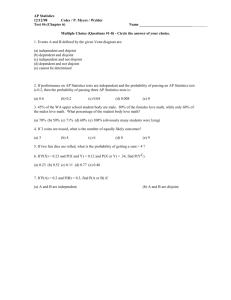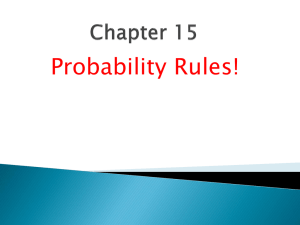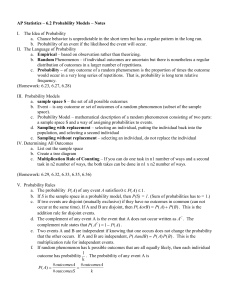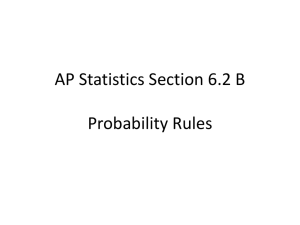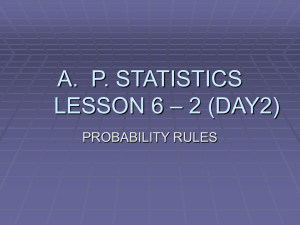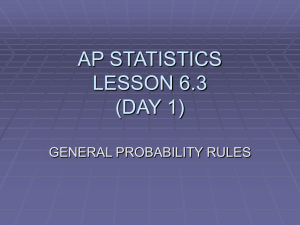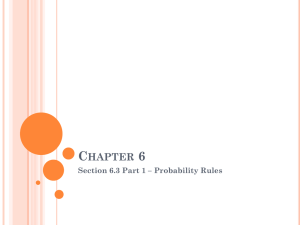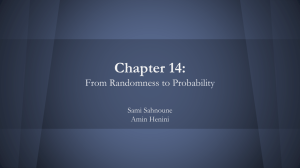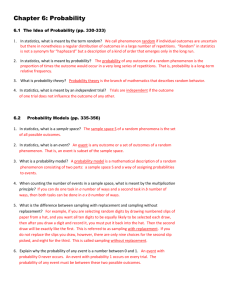A and B
advertisement
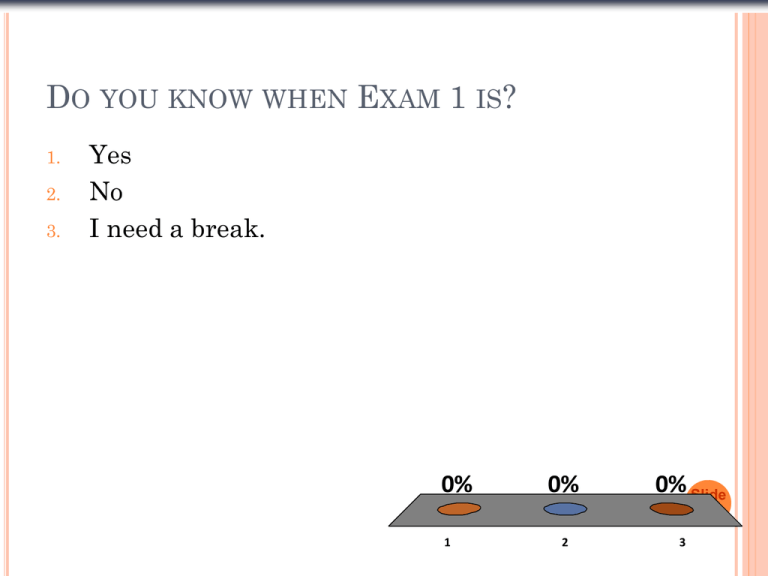
DO YOU KNOW WHEN EXAM 1 IS? 1. 2. 3. Yes No I need a break. 0% 0% 0% Slide 1- 1 1 2 3 UPCOMING IN CLASS Homework 5 due Sunday 9/23 Quiz 3 next Wednesday – Sept 26th (HW4 and HW5) Exam 1 – Oct. 10th CHAPTER 15 Probability Rules! THE GENERAL ADDITION RULE For disjoint events : P(A or B) = P(A) + P(B) For any two events A and B, P(A or B) = P(A) + P(B) – P(A and B) Slide 1- 4 THE GENERAL MULTIPLICATION RULE For independent events P(A and B) = P(A) x P(B) For any two events A and B, P(A and B) = P(A) x P(B|A) Slide 1- 5 DRAWING WITHOUT REPLACEMENT Sampling without replacement means that once one object is drawn it doesn’t go back into the pool. We often sample without replacement, which doesn’t matter too much when we are dealing with a large population. However, when drawing from a small population, we need to take note and adjust probabilities accordingly. Drawing without replacement is just another instance of working with conditional probabilities. Slide 1- 6 HOMEWORK PROBLEM 7 – DEALING WITHOUT REPLACEMENT You are dealt a hand of three cards, one at a time. 4 suits (hearts, clubs, spades, diamond) 26 red 26 black 12 face cards 4 Aces Slide 1- 7 WHAT’S THE PROBABILITY THE FIRST RED CARD YOU GET IS THE 3RD CARD DEALT? 1. 2. 3. 4. ½+½+½ ½*½*½ 26/52 * 25/51 * 26/50 26/52 * 26/52 * 26/52 0% 1 0% 2 0% 3 Slide 0%1- 8 4 WHAT IS THE PROBABILITY THAT YOUR CARDS ARE ALL HEARTS? 1. 2. 3. 4. 13/52 * 12/51 * 11/50 26/52 * 25/51 * 24/50 ¼*¼*¼ ½*½*½ 0% 1 0% 2 0% 3 Slide 0%1- 9 4 WHAT’S THE PROBABILITY THAT YOU GET NO BLACK CARDS? 1. 2. 3. 4. ¾*¾*¾ ¼*¼*¼ 39/52 * 38/51 * 37/50 26/52 * 25/51 * 24/50 0% 0% 0% 0%Slide 1- 10 1 2 3 4 WHAT’S THE PROBABILITY THAT YOU HAVE AT LEAST ONE SPADE? 1. 2. 3. 4. 1- 13/52 * 12/51 * 11/50 1- ¼ * ¼ * ¼ 1- ¼ 1- 39/52 * 38/51 * 37/50 0% 0% 0% 0%Slide 1- 11 1 2 3 4 BATTERY PROBLEM A junk box in your room contains 15 old batteries, 7 of which are totally dead. You start picking batteries one at a time and testing them. Find the probability of each outcome Slide 1- 12 THE FIRST 2 YOU CHOOSE ARE GOOD. 1. 2. 3. 4. 7/15 * 7/15 7/15 * 6/14 8/15 * 8/15 8/15 * 7/14 0% 1 0% 2 0% 3 Slide 0% 1- 13 4 AT LEAST ONE OF THE FIRST 4 BATTERIES WORK. 1. 2. 3. 4. 8/15 * 8/15 * 8/15 * 8/15 1-8/15 * 8/15 * 8/15 * 8/15 1- 8/15 * 7/14 * 6/13 * 5/12 1- 7/15 * 6/14 * 5/13 * 4/12 0% 0% 0% Slide 0% 1- 14 1 2 3 4 YOU HAVE TO PICK 5 BATTERIES ONE THAT WORKS. 1. 2. 3. 4. TO FIND 7/15 * 6/14 * 5/13 * 4/12 * 8/11 7/15 * 6/14 * 5/13 * 5/12 * 4/11 1 – 8/15 * 7/14 * 6/13 * 5/12 * 4/11 8/15 * 7/14 * 6/13 * 5/12 * 4/11 0% 0% 0% 0%Slide 1- 15 1 2 3 4 INDEPENDENT ≠ DISJOINT Disjoint events cannot be independent! Well, why not? Since we know that disjoint events have no outcomes in common, knowing that one occurred means the other didn’t. Thus, the probability of the second occurring changed based on our knowledge that the first occurred. It follows, then, that the two events are not independent. A common error is to treat disjoint events as if they were independent, and apply the Multiplication Rule for independent events—don’t make that mistake. Slide 1- 16 DISJOINT VS. INDEPENDENCE The prerequisite for a required course is that students must have taken either course A or course B. By the time they are juniors, 57% of the students have taken course A, 21% have had course B, and 15% have done both. Slide 1- 17 ARE THE EVENTS OF TEST A AND B DISJOINT? 1. 2. 3. 4. Yes, because the outcome of one influences the probability of the other Yes, because the outcome of one does not influence the probability of the other No, because there are common outcomes between them Yes, because there are no common outcomes Slide 1- 18 WHAT PERCENT OF THE JUNIORS ARE INELIGIBLE FOR THE COURSE? 1. 2. 3. 4. 57 +21 57+21-15 100-(57+21) 100-(57+21-15) 0% 0% 0% 0%Slide 1- 19 1 2 3 4 INDEPENDENCE Independence of two events means that the outcome of one event does not influence the probability of the other. With our new notation for conditional probabilities, we can now formalize this definition: Events A and B are independent whenever P(B|A) = P(B). (Equivalently, events A and B are independent whenever P(A|B) = P(A).) Slide 1- 20 REVERSING THE CONDITIONING Reversing the conditioning of two events is rarely intuitive. Suppose we want to know P(A|B), but we know only P(A), P(B), and P(B|A). We also know P(A and B), since P(A and B) = P(A) x P(B|A) From this information, we can find P(A|B): P(A|B) P(A and B) P(B) Slide 1- 21 WHAT IS THE PROBABILITY THAT A JUNIOR WHO HAS TAKEN COURSE A HAS ALSO TAKEN COURSE B? 1. 2. 3. 4. (57+21-15)/(57) (57+21-15)/(21) (15)/(57) (15)/(21) 0% 1 0% 2 0% 3 Slide 1- 22 0% 4 ARE THE EVENTS INDEPENDENT? 1. 2. 3. 4. No, because the outcome of one influences the probability of the other Yes, because the outcome of one does not influence the probability of the other No, because there are common outcomes between them Yes, because there are no common outcomes Slide 1- 23 TREE DIAGRAMS (CONT.) Figure 15.4 is a nice example of a tree diagram and shows how we multiply the probabilities of the branches together: Slide 1- 24 SOBRIETY CHECKPOINT PROBLEM Police establish a sobriety checkpoint where they detain drivers whom they suspect have been drinking and release those who have not. The police detain 81% of drivers who have been drinking and release 81% of drivers who have not. Assume that 10% of drivers have been drinking. Slide 1- 25 WHAT’S THE PROBABILITY OF ANY GIVEN DRIVER WILL BE DETAINED? 1. 2. 3. 4. .10*.81+.9*.19 .10*.19+.9*.81 .10*.81 .9*.81 0% 0% 0% 0%Slide 1- 26 1 2 3 4 WHAT’S THE PROBABILITY THAT A DRIVER WHO IS DETAINED HAS ACTUALLY BEEN DRINKING? 1. 2. 3. 4. 25.2 / 10 8.1 / 25.2 10 / 25.2 81 / 25.2 0% 1 0% 2 0% 3 Slide 0% 1- 27 4 WHAT’S THE PROBABILITY THAT A DRIVER WHO WAS RELEASED HAD ACTUALLY BEEN DRINKING? 1. 2. 3. 4. 1.9 / 25.2 72.9 / 25.2 1.9 / 74.8 72.9 / 25.2 0% 1 0% 2 0% 3 Slide 0% 1- 28 4 ONE MORE TREE PROBLEM Dan’s Diner employs three dishwashers. Al washes 60% of the dishes and breaks only 2% of those he handles. Betty and Chuck each wash 20% of the dishes, and Betty breaks only 2% of hers, but Chuck breaks 4% of the dishes he washes. You go to Dan’s for supper one night and hear a dish break at the sink. Slide 1- 29 WHAT’S THE PROBABILITY CHUCK BROKE THE DISH? 1. 2. 3. 4. .008/(.008+.004+.012) .012/(.008+.004+.012) .008/(.04) .008/(.96) 0% 0% 0% 0%Slide 1- 30 1 2 3 4 WHAT’S THE PROBABILITY THAT AL BROKE THE DISH? 1. 2. 3. 4. .008/(.008+.004+.012) .012/(.008+.004+.012) .008/(.04) .008/(.96) 0% 0% 0% 0%Slide 1- 31 1 2 3 4 UPCOMING IN CLASS Homework 5 due Sunday 9/23 Chapter 16 – Random Variables, Expected Values, and Variance and Standard Deviations of Random Variables Quiz 3 next Wednesday – Sept 26th (HW4 and HW5) Exam 1 – Oct. 10th Slide 1- 32

